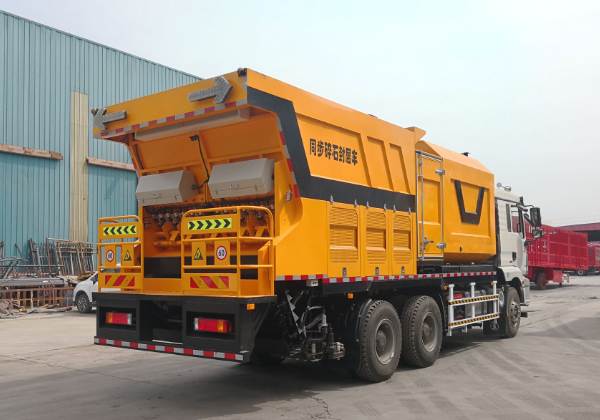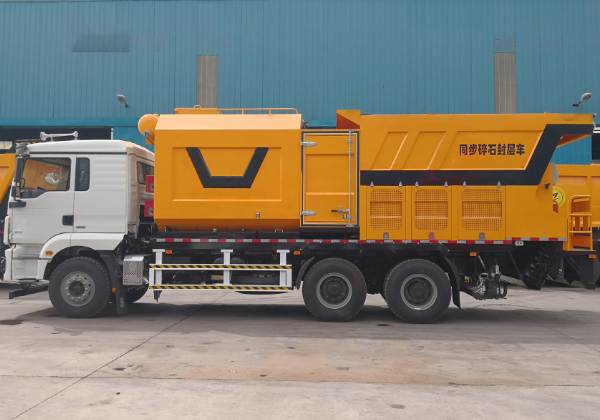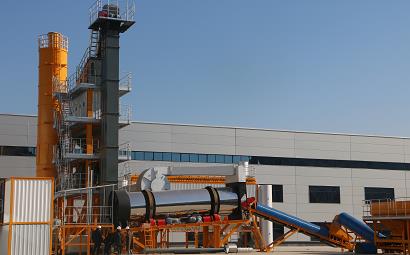Application of asphalt gravel synchronous sealing truck in road construction
The base layer of asphalt pavement is divided into semi-rigid and rigid. Since the base layer and the surface layer are materials of different properties, good bonding and continuity between the two are the top requirements for this type of pavement. In addition, when the asphalt surface layer seeps water, most of the water will be concentrated at the joint between the surface layer and the base layer, causing damage to the asphalt pavement such as slurry, looseness, and potholes. Therefore, adding a lower seal layer on top of a semi-rigid or rigid base layer will play a vital role in enhancing the strength, stability and waterproofing capabilities of the pavement structural layer. The more commonly used one is to use asphalt gravel synchronous sealing technology.
Lower sealing layer
Inter-layer connection
There are obvious differences between asphalt surface layer and semi-rigid or rigid base layer in terms of structure, composition materials, construction technology and time. A sliding surface is objectively formed between the surface layer and the base layer. After adding the lower sealing layer, the surface layer and the base layer can be effectively connected into one.
Transfer load
Asphalt surface layer and semi-rigid or rigid base layer play different roles in the pavement structural system. The asphalt surface layer mainly plays the role of anti-skid, waterproof, anti-noise, anti-shear slip and cracks, and transfers load to the base layer. To achieve the purpose of transmitting load, there must be strong continuity between the surface layer and the base layer. This continuity can be achieved through the function of the lower sealing layer (adhesive layer, permeable layer).


Improve road strength
The elastic modulus of the asphalt surface layer and the semi-rigid or rigid base layer are different. When they are combined together and subjected to load, the stress diffusion modes of each layer are different and the deformation is also different. Under the action of the vertical load and lateral impact force of the vehicle, The surface layer will have a displacement trend relative to the base layer. If the internal friction and bonding force of the surface layer itself and the bending and tensile stress at the bottom of the surface layer cannot withstand this shifting stress, the surface layer will suffer from pushing, rutting, and even loosening and peeling. Therefore, an additional force must be provided to Prevent this movement between layers. After adding the lower sealing layer, the friction and bonding force to prevent movement are increased between the layers, which can undertake the bonding and transition tasks between rigidity and softness, so that the surface layer, base layer, cushion layer and soil foundation can resist the load together. In order to achieve the purpose of improving the overall strength of the road surface.
Waterproof and impermeable
In the multi-layered structure of highway asphalt pavement, at least one layer must be a type I dense-grade asphalt concrete mixture. Its purpose is to enhance the density of the surface layer and prevent surface water from eroding and damaging the pavement and pavement base. But this alone is not enough, because in addition to design factors, the construction of asphalt concrete is also affected by many factors such as asphalt quality, stone properties, stone specifications and proportions, oil-stone ratio, mixing and paving equipment, rolling temperature, rolling time, etc. Impact. The surface layer, which should have good density and almost zero water permeability, often has a high water permeability due to a certain link not being in place, thus affecting the anti-seepage ability of the asphalt pavement. It even affects the stability of the asphalt pavement itself, the base layer and the soil foundation. Therefore, the "Technical Specifications for Construction of Highway Asphalt Pavement" clearly stipulates that when it is located in a rainy area and the asphalt surface layer has large gaps and serious water seepage, a lower sealing layer should be laid under the asphalt surface layer.
Lower seal layer construction plan
The working principle of synchronous gravel sealing is to use special construction equipment, the synchronous gravel sealing machine, to spray high-temperature asphalt and clean, dry and uniform stones on the road surface almost simultaneously, ensuring that the asphalt and stone are sprayed on the road surface in a short time. Complete the combination and continuously strengthen the strength under the action of external load.
Different types of asphalt binders can be used for the simultaneous sealing of asphalt gravel: softened pure asphalt, polymer SBS modified asphalt, emulsified asphalt, polymer modified emulsified asphalt, diluted asphalt, etc. At present, the most widely used process in China is to heat ordinary hot asphalt to 140°C or heat SBS modified asphalt to 170°C. Use an asphalt spreading truck to evenly spray the asphalt onto the surface of the rigid or semi-rigid base layer, and then spread the aggregate evenly. The aggregate is made of limestone gravel with a particle size of 13.2~19mm. It should be clean, dry, non-weathered, free of impurities, and have good particle shape. The amount of gravel should be between 60% and 70% of the full paving area.
The dosage of asphalt and aggregate is controlled according to the maximum amount of 1200kg·km-2 and 9m3·km-2 respectively. Construction according to this plan requires high accuracy in the amount of asphalt spraying and aggregate spreading, so the asphalt gravel synchronous sealing truck must be used for construction. On the top surface of the cement-stabilized gravel base that has been sprayed through, spread hot asphalt or SBS modified asphalt in an amount of about 1.2~2.0kg·km-2, and then evenly spread a layer of gravel with a single particle size on top. The size of the gravel and gravel particle size should match the particle size of the asphalt concrete paved on the waterproof layer. Its spreading area is 60% to 70% of the full pavement, and then the rubber tire roller is used to stabilize the pressure 1 to 2 times to form. The purpose of spreading single-size gravel is to protect the waterproof layer from being damaged by the tires of construction vehicles such as trucks and asphalt mixture paver tracks during the construction process, and to prevent the modified asphalt from being melted by high-temperature climate and hot asphalt mixture. The wheel will stick and affect the construction.
Theoretically, the gravels are not in contact with each other. When paving asphalt mixture, the high-temperature mixture will enter the gaps between the gravels, causing the modified asphalt membrane to melt by heat. After rolling and compacting, the white gravel becomes Asphalt gravel is embedded in the bottom of the asphalt structural layer to form a whole, and an "oil-rich layer" of about 1.5cm is formed at the bottom of the structural layer, which can effectively act as a waterproof layer.
 Albanian
Albanian  Russian
Russian  Arabic
Arabic  Amharic
Amharic  Azerbaijani
Azerbaijani  Irish
Irish  Estonian
Estonian  Odia (Oriya)
Odia (Oriya)  Basque
Basque  Belarusian
Belarusian  Bulgarian
Bulgarian  Icelandic
Icelandic  Polish
Polish  Bosnian
Bosnian  Persian
Persian  Afrikaans
Afrikaans  Tatar
Tatar  Danish
Danish  German
German  French
French  Filipino
Filipino  Finnish
Finnish  Frisian
Frisian  Khmer
Khmer  Georgian
Georgian  Gujarati
Gujarati  Kazakh
Kazakh  Haitian Creole
Haitian Creole  Korean
Korean  Hausa
Hausa  Dutch
Dutch  Kyrgyz
Kyrgyz  Galician
Galician  Catalan
Catalan  Czech
Czech  Kannada
Kannada  Corsican
Corsican  Croatian
Croatian  Kurdish (Kurmanji)
Kurdish (Kurmanji)  Latin
Latin  Latvian
Latvian  Lao
Lao  Lithuanian
Lithuanian  Luxembourgish
Luxembourgish  Kinyarwanda
Kinyarwanda  Romanian
Romanian  Malagasy
Malagasy  Maltese
Maltese  Marathi
Marathi  Malayalam
Malayalam  Malay
Malay  Macedonian
Macedonian  Maori
Maori  Mongolian
Mongolian  Bengali
Bengali  Myanmar (Burmese)
Myanmar (Burmese)  Hmong
Hmong  Xhosa
Xhosa  Zulu
Zulu  Nepali
Nepali  Norwegian
Norwegian  Punjabi
Punjabi  Portuguese
Portuguese  Pashto
Pashto  Chichewa
Chichewa  Japanese
Japanese  Swedish
Swedish  Samoan
Samoan  Serbian
Serbian  Sesotho
Sesotho  Sinhala
Sinhala  Esperanto
Esperanto  Slovak
Slovak  Slovenian
Slovenian  Swahili
Swahili  Scots Gaelic
Scots Gaelic  Cebuano
Cebuano  Somali
Somali  Tajik
Tajik  Telugu
Telugu  Tamil
Tamil  Thai
Thai  Turkish
Turkish  Turkmen
Turkmen  Welsh
Welsh  Uyghur
Uyghur  Urdu
Urdu  Ukrainian
Ukrainian  Uzbek
Uzbek  Spanish
Spanish  Hebrew
Hebrew  Greek
Greek  Hawaiian
Hawaiian  Sindhi
Sindhi  Hungarian
Hungarian  Shona
Shona  Armenian
Armenian  Igbo
Igbo  Italian
Italian  Yiddish
Yiddish  Hindi
Hindi  Sundanese
Sundanese  Indonesian
Indonesian  Javanese
Javanese  Yoruba
Yoruba  Vietnamese
Vietnamese  Hebrew
Hebrew  Chinese (Simplified)
Chinese (Simplified)







